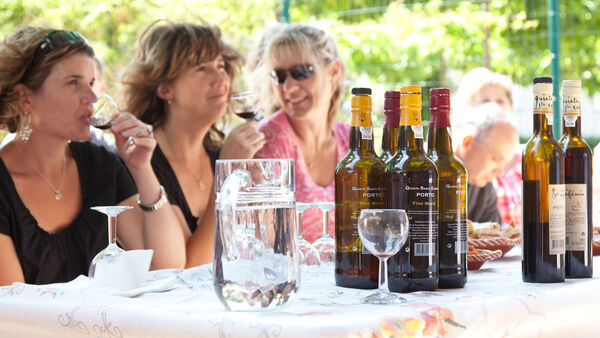Putting the Port in Portugal
True port wine comes only from vines grown on the terraced hillsides of the Douro Valley — with roots that stretch all the way to England.

By Rick Steves and Cameron Hewitt
Quite possibly, port wine was invented accidentally — when a pair of English brothers, before taking a shipment of Portuguese wine back to England in the late 1600s, fortified the wine with grape brandy to maintain its quality during the long trip.
Because Britain isn't suitable for growing grapes, its citizens have long imported wine from France. But in the 17th and 18th centuries, when Britain was at war with France, they boycotted enemy wine and went looking elsewhere for grape-based refreshment.
The brandy-fortified wine from Portugal picked up the flavor of the oak en route back to Blighty — a taste the English grew to appreciate. In 1703, a treaty reduced taxation on Portuguese wines, making port even more popular. In 1756, Portugal's Marquês de Pombal demarcated the Douro region — the first such designation in Europe. From then on, true "port wine" came only from this region, following specific regulations of production, just as "Champagne" technically refers to wines from that region of France.
The hills and curves of the Douro Valley produce striking microclimates: A few miles can make a tremendous difference in terms of temperature, precipitation, humidity, and farming conditions. Even within the same vineyard, each parcel of land has its own characteristics. These subtle changes infuse the grapes with completely different aromas and flavors.
Near the river's mouth in Porto, its valley has moderate temperatures and a fair amount of precipitation. About 55 miles inland, chains of mountains mark a dramatic change in climate: very hot and dry in summer, with heavy rainfall and extreme cold in winter. Over the years, vintners have learned to micromanage their grapes, fine-tuning specific qualities to get the very best port for their conditions.
The terrain around the Douro is dominated by sedimentary rocks that have been buried, heated, and deformed into a metamorphic rock called schist. The easily fractured layers of schist are tilted beneath the soil at an angle, allowing winter rainfall to easily penetrate the earth and build up in underground reserves. The grapevines' roots plunge deep into the ground — up to 30 feet — to reach this water through the long, dry summer.
Traditionally, the Douro's farms and land were owned by locals, while the British bought the wine from them, aged it in Porto, and handled the export business. But that arrangement changed in the late 19th century, when an infestation of an American root insect called phylloxera, which had smuggled itself to the Old World in the humid climate of speedy steamboats, devastated much of Europe's wine industry.
Lasting evidence of the phylloxera infestations is visible in the Douro's "dead" terraces, still overgrown with weeds and a smattering of olive trees. These terraces had been treated with harsh chemicals that contaminated the soil, rendering it no longer suitable for grapes.
Other terraces, however, were left untouched by Portuguese vintners who had simply given up in the face of the infestation. Unable to produce usable grapes for over a decade, they sold their land to British companies who were willing to wait until a solution could be found. It was, as phylloxera-resistant American rootstock began to be used throughout Europe. Port production resumed, this time on British-owned land.
The British perfected port production in the succeeding centuries — which is why many ports carry British-sounding names such as Taylor, Croft, and Graham. (And though it's largely undiscovered by Americans, this region has long been a real hot spot among wine-loving Brits.)
Building and maintaining the Douro's trademark terraces is expensive, and grapes planted there must be cultivated by hand. In recent years bigger companies have attempted using larger terraces that can be worked by machines, or have tried smoothing out the hillside and planting the vines in vertical rows. Within the demarcated region, farmers are not allowed to irrigate except with special permission.
To make the finest port, many vineyards along the Douro still stomp grapes by foot — not out of deference to tradition, but because machines break the grapes' seeds, thereby releasing too many tannins, which makes for bitter port. But soft soles against stone keep the seeds intact. During harvest time (mid-September through early October), the grapes are poured into big granite tubs called lagares. A team of two dozen stompers line up across from each other, put their arms on each other's shoulders, and march, military-style, to crush the grapes. The stomping can last three to four days, and generally devolves into a party atmosphere — with tourists sometimes joining in…but only later in the evening, after the serious work is done.
Port traditionally stays in the Douro Valley for one winter after it's made, as the cold temperatures encourage the wine and brandy to marry. Then it's taken to Porto, where the milder, more humid climate is ideal for aging. For centuries, port could only be legally aged, marketed, and sold in Porto. But this was deregulated in 1987, and now any Douro quinta (port-producing vineyard) that offers tours can sell its port directly to visitors.
In recent years, Douro vintners have been using their traditional port grapes to make table wines — with great success. These days, most quintas offer you tastes not only of port, but of their vinhos do Douro, which are gaining international acclaim.
Cameron Hewitt is the co-author of several Rick Steves guidebooks.

